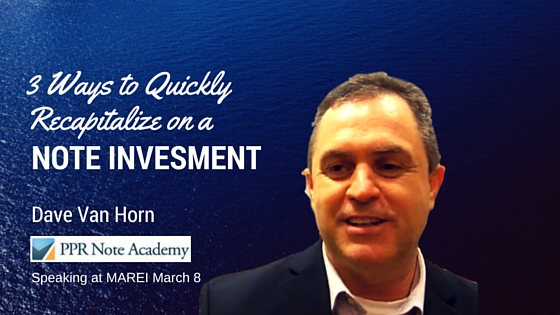
Recently, a fellow investor asked me how they could make money by investing in notes. This is a very broad question, and the truth is that there are an infinite number of ways to make money by investing in notes, just as there are by investing real estate.
So, the real question then becomes, “how quickly can I make money?”
Oftentimes, if you buy real estate notes that are in default, the money is made either by exiting through the borrower (like by using a modified payment plan or short sale for example) or through the property (foreclosure, deed in lieu, etc.).
If you decide that you want to recapitalize sooner rather than later, you can implement more of a velocity model, either by selling the note, selling a partial note, or creating a collateral assignment of note and mortgage.
Selling or Flipping the Note
An asset can always be sold, whether re-performing or non-performing. Note buyers can be found almost anywhere. Some of the best places to start are local REIA meetings or real estate and note meetup groups. You can even try websites like FCI Exchange, Loan MLS, Bigger Pockets, and a variety of LinkedIn groups.
Of course, the best buyer is the one who is already a customer, so some of the best ways to proactively continue sales could be to provide reps and warrants with notes to give buyers more security, as well as offering them quality collateral and follow-up service.
Another option is to flip the note, essentially buying it for one price and selling it for another. For example, if you went through the work of purchasing a note wholesale, you can sell it at retail value either ‘as is’ or you can modify it.
If you purchased a non-performing note and you are able to get it re-performing, as the asset brings in payments each month it becomes more and more valuable. So, you could sell it for a higher price based on the length of pay history.
Another strategy to recapitalize is that you, as the note owner, could sell part of the note to another investor.
For example, if you had purchased a 15 year note, you could sell the first 10 years of monthly payments to an investor. By doing so, you could reclaim your initial note investment, while still remaining entitled to the last 5 years of payments. You would have less risk in that particular note deal. And, you are free to re-invest your capital into another opportunity.
Collateral Assignment of Note and Mortgage
Lastly, there’s the unique strategy of utilizing a Collateral Assignment of Note and Mortgage. This would enable you (the note owner) to borrow money from an investor and use the promissory note as collateral.
This is really where the velocity factor comes in, especially if you use the borrowed capital to purchase more notes, again utilizing leverage, creating exponential growth. Also, it’s a great way to recapitalize tax-free because it’s a loan, just like a real estate investor refinancing a rental property.
So, if you’re looking to recapitalize quickly on a note investment, or if you’re at all concerned about liquidity, one of these strategies could help.